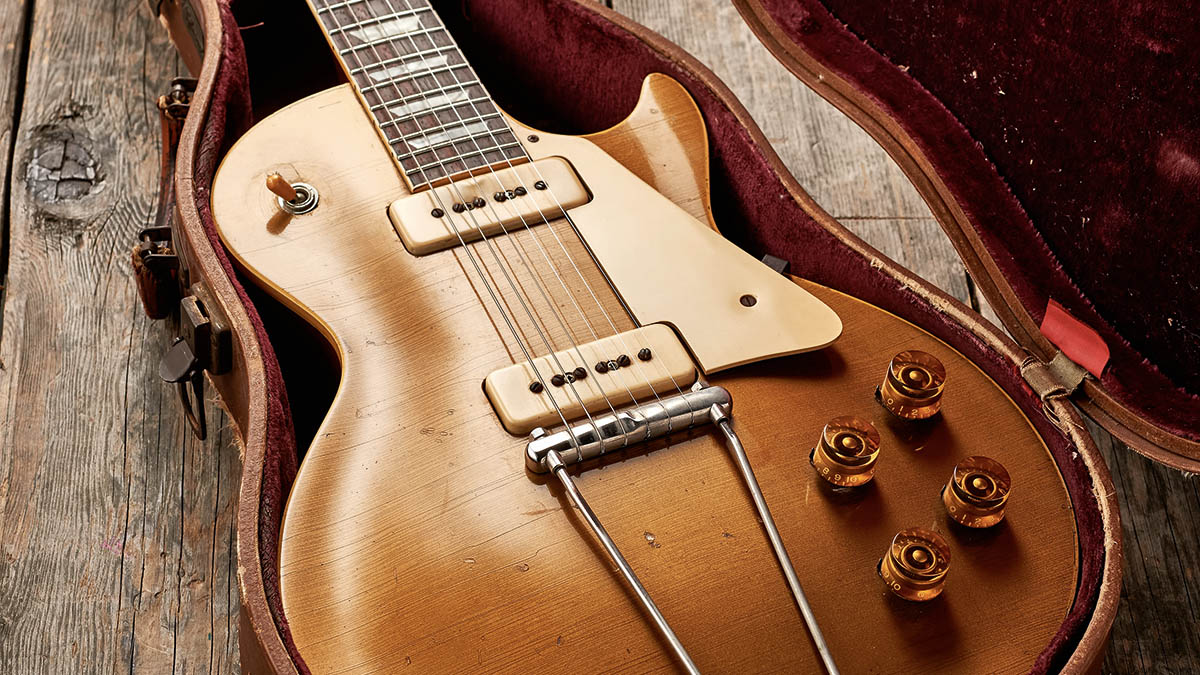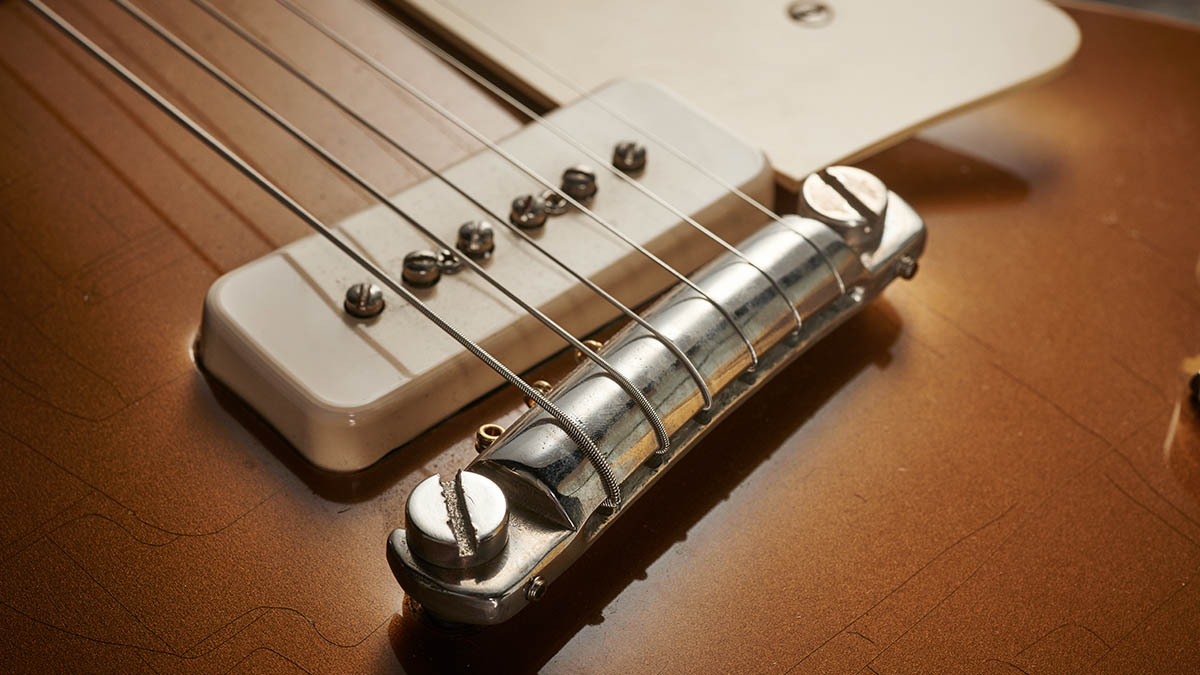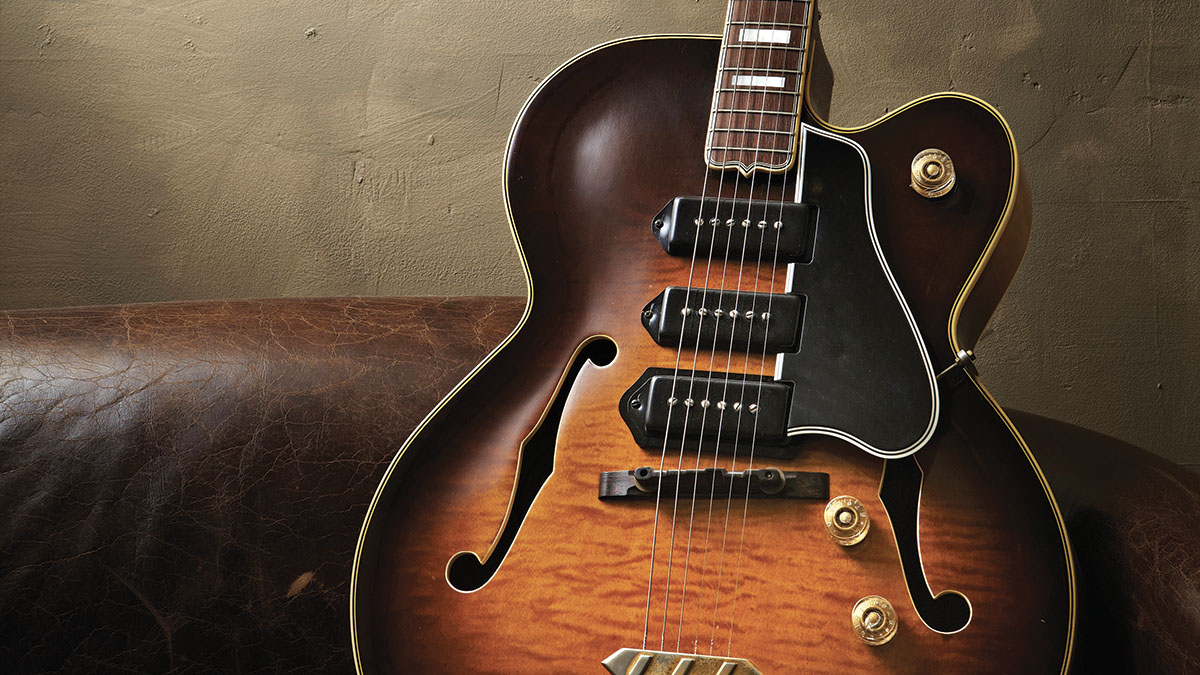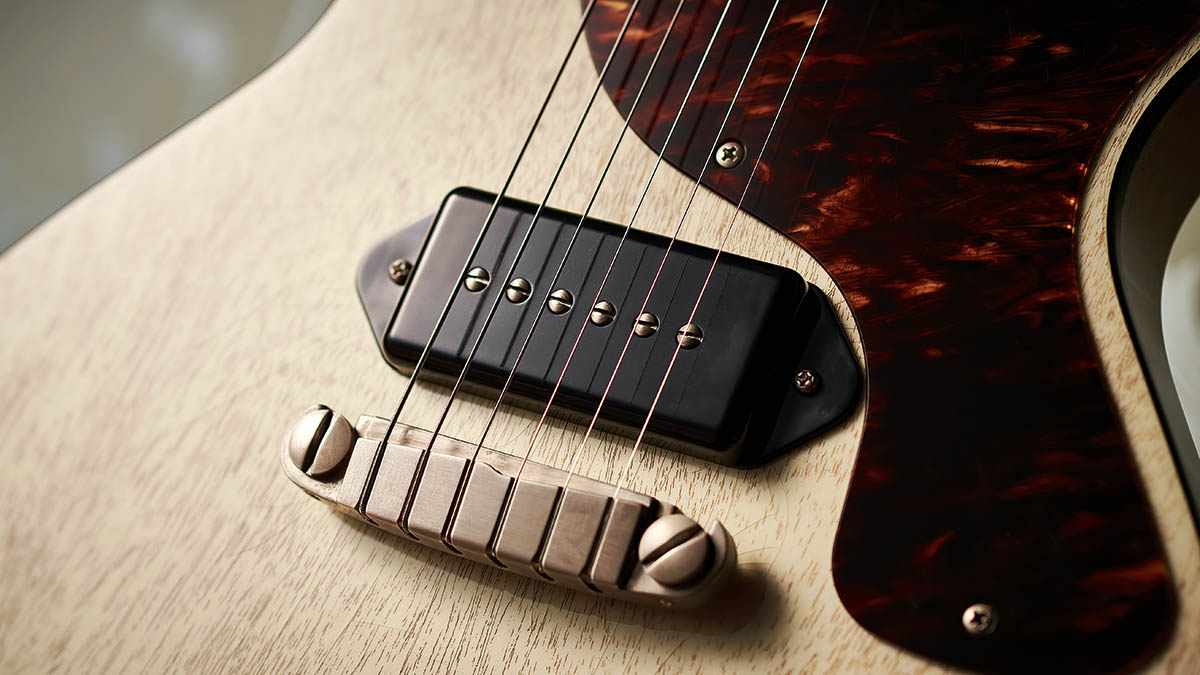
The P-90’s lineage goes back to the 1930s, when Gibson’s first electric guitar pickup appeared on the ES-150. It became so synonymous with the era’s greatest jazz guitarist that the pickup became universally known as the ‘Charlie Christian’.
It pre-dated the development of Alnico magnets, and Gibson’s pickup designers needed massive cobalt magnets to achieve the necessary gauss. The ‘Charlie Christian’ was wound with 38AWG magnet wire and weighed a hefty 2lb.
In 1940, Gibson came up with an unusual diagonally mounted pickup that stretched almost all the way from the neck to the bridge. This had evolved into a shorter version by 1941, with two Alnico bar magnets and a steel keeper bar positioned under the coil, adjustable pole screws and a plastic cover with rounded ends.
Walt Fuller, the head of Gibson’s electronics department, developed a more compact pickup using Alnico magnets. With a rectangular metal cover and height adjustment screws at each end, the P13 measured 84mm long and 35mm wide.
Introduced in 1940, the P13 was fitted to ES-100, ES-125 and ES-150 guitars, as well as lap steels. This highly regarded pickup continued to feature on Silvertone and Harmony guitars long after Gibson stopped using it, and it’s a great-sounding vintage option for Tele neck conversions.
The P-90

Walt Fuller was soon back at work after WWII, and by 1946 he had combined features from the shorter diagonal pickup and the P13 to create the P-90. It featured adjustable polepieces, with a machine-wound coil of 42AWG plain enamel and a black styrene bobbin.
Fuller positioned two 2.44-inch sandcast Alnico magnets below the bobbin, with a steel keeper bar separating them. Both south poles faced towards the central polepieces, so the magnetic field flowed through the centre of the coil and around its outer edges.
All the latest guitar news, interviews, lessons, reviews, deals and more, direct to your inbox!
The magnets that Gibson used during the 1950s is a much-debated topic. While working as the head of Gibson’s Custom Shop, Edwin Wilson had six bar magnets from vintage PAFs analysed. Despite company records showing that Gibson always ordered Alnico II, four of the magnets turned out to be Alnico III, along with one IV and a II.
Matthew Bascetta of House Of Tone Pickups confirms that P-90s magnets also varied. “All the early ones were Alnico III,” he explains, “but just like PAFs, as you get to the late 1950s, you’ll get a mixture of Alnico II, III and occasionally IV and V. From about 1961, it was pretty much all V.”

Vintage-era coils were never wax or lacquer potted, but they were wrapped with insulating tape. Two leadout wires protruded through the steel baseplate and were soldered to a braided single-core output wire. A metal retainer was screwed onto the baseplate to secure the braided wire. The cold connection was soldered to the braiding and Gibson used paper masking tape to insulate the hot wire connection.
There are two styles of baseplate. Those with protruding ends are fitted to Les Paul and SG Juniors, plus hollow-bodied models such as the ES-125, ES-225 and ES-330. The plastic covers have extensions at each end with screw holes to fully cover the baseplate and provide a means of securing the pickup to the body.
These P-90s are called ‘dog-ears’ and shims are needed to adjust the height. P-90s intended for Les Paul Goldtops, Customs or Specials have two fixing screw holes positioned between the A and D polepieces and the G and B. The fixing screws go straight into the body and shims, foam or springs can be used for height adjustment. These P-90s are known as ‘soapbars’.
Variations in the key of P
In 1946, some P-90s with non-adjustable Alnico rod magnets were fitted to ES-125s. Then in 1952, bridge P-90s on the very earliest Les Paul Goldtops had fixing screws positioned in two corners. Gibson fitted a smaller version of the P-90 to electric mandolins and tenor guitars and, in the UK, techs affectionately refer to this version as ‘the P45’.
The staple P-90’s construction was significantly different, however. Permanent magnets with a rectangular cross section were used instead of bar magnets. With small screws for individual height adjustment, the design resembles the DeArmond Dynasonic favoured by Gretsch during that time.
It has been suggested that Les Paul preferred the DeArmond tone and fitted one in the neck position of his Number 1 Goldtop. Les’s tech Tom Doyle disputes this, reporting that Les wound his own pickups using DeArmond magnets. Perhaps the staple P-90 was designed to get the DeArmond tone from a Gibson-branded pickup and keep Les sweet. Gibson installed them on various jazzboxes as well as pre-1957 Les Paul Customs.
Shapes in flux
P-90 coils are shorter and wider than most Fender pickup coils and Matthew Bascetta provides us with some more insights: “Coil shape influences the magnetic flux field’s shape and how wide the field extends from the core at the polepiece screws,” he says. “The P-90’s coil and the use of dual bar magnets makes the field extremely wide.
“A wide magnetic aperture picks up more of the string oscillation and that enables P-90s to capture more bass and low mid frequencies,” he adds. “It also provides a bit more sustain than a narrow Fender-style coil, which will have a sharper decay.”
Jason Lollar describes inductance as “a measure of the physical property to induce a current”. And since all pickups are current generators, higher inductance means higher output. Strong magnets raise inductance and by having two full sized magnets, P-90 inductance is high by single-coil standards.

Walt’s wonder
The P-90 was Gibson’s premium pickup from 1946 until 1957, and it was installed on everything from the most exquisite jazz guitars to lowly student models such as the Les Paul Junior. If you bought a Gibson electric during that era, a P-90 or two was part of the deal. And that’s why they’ve excelled in pretty much every genre of guitar music.
You could even make the case that the P-90 is the most versatile pickup ever made. We can’t imagine playing death metal on a Tele, nailing an authentic jazz tone with a Strat or chicken pickin’ with a humbucker, but we’d feel pretty confident about covering all those bases with a good P-90.
Although Gibson’s top models transitioned to humbuckers from 1957 onwards, if you compare early PAFs with P-90s from that time then the sonic similarities are more apparent than the differences.
Seth Lover tends to get all the plaudits for designing Gibson’s PAF humbucker, but Walt Fuller deserves equal recognition. P-90s literally set the tone – and they’re probably more popular now than ever before.
Huw started out in recording studios, working as a sound engineer and producer for David Bowie, Primal Scream, Ian Dury, Fad Gadget, My Bloody Valentine, Cardinal Black and many others. His book, Recording Guitar & Bass, was published in 2002 and a freelance career in journalism soon followed. He has written reviews, interviews, workshop and technical articles for Guitarist, Guitar Magazine, Guitar Player, Acoustic Magazine, Guitar Buyer and Music Tech. He has also contributed to several books, including The Tube Amp Book by Aspen Pittman. Huw builds and maintains guitars and amplifiers for clients, and specializes in vintage restoration. He provides consultancy services for equipment manufacturers and can, occasionally, be lured back into the studio.



